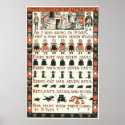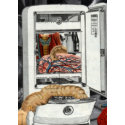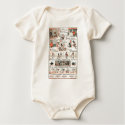Instructions for crocheting this cute purse come from the February 1971 issue of The Workbasket.
Thursday, April 28, 2011
Crochet A Handbag With A Button Tab Closure
Posted by Deanna Dahlsad
1 comments
Labels:
Crafty,
Needlework
![]()
Wednesday, April 27, 2011
Lemon Juice & Acidic Rubs For Fowl & Meats
Posted by Deanna DahlsadThis clipping from a vintage Modern Woman magazine (volume 17 number 1, 1948) recommends rubbing lemon juice into a fowl before roasting to make the meat more tender and to lighten it. I've heard/read lots of similar tips regarding lemon juice, tomato, and other naturally acidic foods (alone or in marinades) to tenderize meats (Hello, salisbury steak tomato sauce recipes for cheap tough cuts of meat!), but I don't recall anyone commenting on lightening the meat... Come to think of it, I've never heard anyone complain about meat that's "too dark" -- unless it was burnt *wink*
0
comments
Labels:
Cooking,
Food,
Vintage Magazines
![]()
Tuesday, April 26, 2011
Unhappy Meals, Unhappy Relationships
Posted by Deanna DahlsadI know the title sounds like this post is going to be about getting fussy kids to eat at meal time; but it's not. Well, at least not in terms of parenting. It's about all of us eating poorly and forging bad relationships -- not only with food in addictive ways, either, as you'll see...
Over at Kitchen Preserve (where there are some great recipes!), I was reading Rebecca's "about" page where I found this incredible bit:
The writer Michael Pollan says that we should not “eat anything your great great-grandmother would not recognize as food.” Pollan means that we should eat whole, natural, unprocessed foods. But specifically, what did our great great-grandmothers eat? Do you know? I wish I knew more details of my ancestor’s recipes–but unfortunately no one ever wrote much down.(Rebecca should read more vintage and antique cookbooks, magazines and publications -- she'd likely be surprised!)
In Pollan's article, Unhappy Meals, the author explores the history behind our current bad diets. The article is long, but absolutely recommended reading. Today, this part sticks out:
No one likes to admit that his or her best efforts at understanding and solving a problem have actually made the problem worse, but that’s exactly what has happened in the case of nutritionism. Scientists operating with the best of intentions, using the best tools at their disposal, have taught us to look at food in a way that has diminished our pleasure in eating it while doing little or nothing to improve our health. Perhaps what we need now is a broader, less reductive view of what food is, one that is at once more ecological and cultural. What would happen, for example, if we were to start thinking about food as less of a thing and more of a relationship?Clearly living off the land, near the land, with the earth, is better for all who live on it.
In nature, that is of course precisely what eating has always been: relationships among species in what we call food chains, or webs, that reach all the way down to the soil. Species co-evolve with the other species they eat, and very often a relationship of interdependence develops: I’ll feed you if you spread around my genes. A gradual process of mutual adaptation transforms something like an apple or a squash into a nutritious and tasty food for a hungry animal. Over time and through trial and error, the plant becomes tastier (and often more conspicuous) in order to gratify the animal’s needs and desires, while the animal gradually acquires whatever digestive tools (enzymes, etc.) are needed to make optimal use of the plant. Similarly, cow’s milk did not start out as a nutritious food for humans; in fact, it made them sick until humans who lived around cows evolved the ability to digest lactose as adults. This development proved much to the advantage of both the milk drinkers and the cows.
It's not just the extra work we do preparing our foods that keeps us fit (even more so when we garden and grow our own food) or that cooking our own food keeps more of the natural nutrients in our food than processed food-stuffs does, but that we build relationships. Relationships with the cycle of life, the planet and those who inhabit it with us, and relationships with those we spend time growing, preparing and eating with.
I don't think it's possible or advisable for us all to be farmers and produce (grow and raise) all that we eat. But I do think we'd benefit from asking ourselves if what we are putting into our bodies could actually be something we could produce.
If not, we probably shouldn't be eating it.
Which reminds me, will you be watching Jamie Oliver's Food Revolution tonight?
4
comments
Labels:
Cooking,
Food,
Health,
Vintage Living
![]()
Tuesday, April 12, 2011
Airing Out My Thoughts On Clothespins
Posted by Deanna DahlsadI was reading over at In The Labyrinth where these hand-painted clothespins from Made with Love by Hannah were posted -- and my head exploded with thoughts about clothespins.
First of all, as I noted here about these vintage "Clean-Grip" figural clothespins, plastic clothespins do not stain, discolor, or soil the wet laundry like wooden and/or metal clothespins can; plastic clothespins don't splinter either. However, because the plastic ones -- adorable vintage ones or not -- were more expensive, most of us are more familiar with the wooden varieties. [Put a (clothes) pin in that; I'll get back to the familiarity of clothespins in a bit.]
While these hand painted wooden clothespins are utterly charming, I do have some practical concerns... I don't see them for sale at the site, so I don't know if these are varnished or sealed in any way to prevent the paint from adhering to wet laundry -- or, for that matter, even to sticking to or rubbing off on on dry textiles. (Something that as a collector of textiles should consider before even using them indoors to display items.) But in any case, there are practical matters to consider regarding painted wooden clothespins.
That said...
I'm sure most of us recall the various craft projects involving painting wooden clothespins we did as kids. I vividly remember painting the traditional wooden clothes pins to look like soldiers, adding glitter and pom-pons at the top for hats, to make ornaments for the Christmas tree in Girl Scouts. I also remember most of us were not familiar with this form of clothespins; we were used to the wooden ones with metal springs. But we knew what clothespins where. And not in some abstract or crafting-only way either. Back then, we saw laundry hanging on the line to dry -- often we'd helped to put it there.
This is another one of those things I've seen change, nearly disappear, in my lifetime of 46 years.
It's not (just) that appliances were part of the consumption mentality marketed to Americans, but that as more women entered the workforce (either as women's libbers who sought careers, like my mother, or as the economy forced both parents to work outside the home) hanging the laundry outside to dry was no longer practical.
I don't recall the pivotal moment when the habit of hanging wet laundry outside to dry ended in my childhood -- but I do distinctly remember having a conversation with my mother, when I was an adult with a child of my own, that drove the point home.
One early spring day she had called me at home, around lunchtime as she often did then, and asked how the day was going. I had told her I had just finished hanging the laundry out to dry. She was so jealous I could hear it resonate over the phone as she talked about that being one of the first real signs of spring, how the sheets smelled so good...
I asked her why she didn't go home and do the same? She sighed and said even if she had started the load of laundry in the morning and drove straight home to hang the laundry outside, there wasn't enough time to have it dry before it was dark. Plus, there was dinner etc. to deal with then. And once, she did hang the laundry out to dry while she was at work, but it rained and what laundry hadn't been blown to the ground was still covered in dirt splashing up from the ground, etc. One really had to be home to notice the weather changes and respond to it.
So despite the sensual delights in hanging laundry out to dry, and the economic savings too, the whole practice has become one based on the luxury of time.
Nowadays, kids likely aren't even familiar with crafting with clothespins. In part because crafting isn't what it once was. And because now the plastic clothespins are cheaper than wooden ones. But maybe we can change that *wink*
8
comments
Labels:
Crafty,
Household Tips,
Traditions,
Vintage Living,
Women
![]()
Practical Fish Guide
Posted by Deanna DahlsadThis guide to cooking fish is from Fish Facts, copyright 1938, Ronald Lichter; courtesy of Schwarz Fish Co., Dealers in Fresh Fish & Sea Food, Sheboygan, Wisconsin. The spiffy thing is that it tells you if the particular fish is lean or fat, the best season or time of year, and the best ways to prepare it (broil; bake; boil, steam, poach; fry, saute).
0
comments
Labels:
Cooking,
Food,
Guides,
Shopping Tips
![]()
Monday, April 11, 2011
Wednesday, April 6, 2011
Quick List Links
Posted by Deanna DahlsadI'd like to thank Mama Says for including Things Your Grandmother Knew in her list of Favorite Frugal, Simple, Green Living blogs.
Things Your Grandmother Knew also made the list of Top 50 Household Cleaning Blogs.
0
comments
Labels:
Household Tips
![]()























